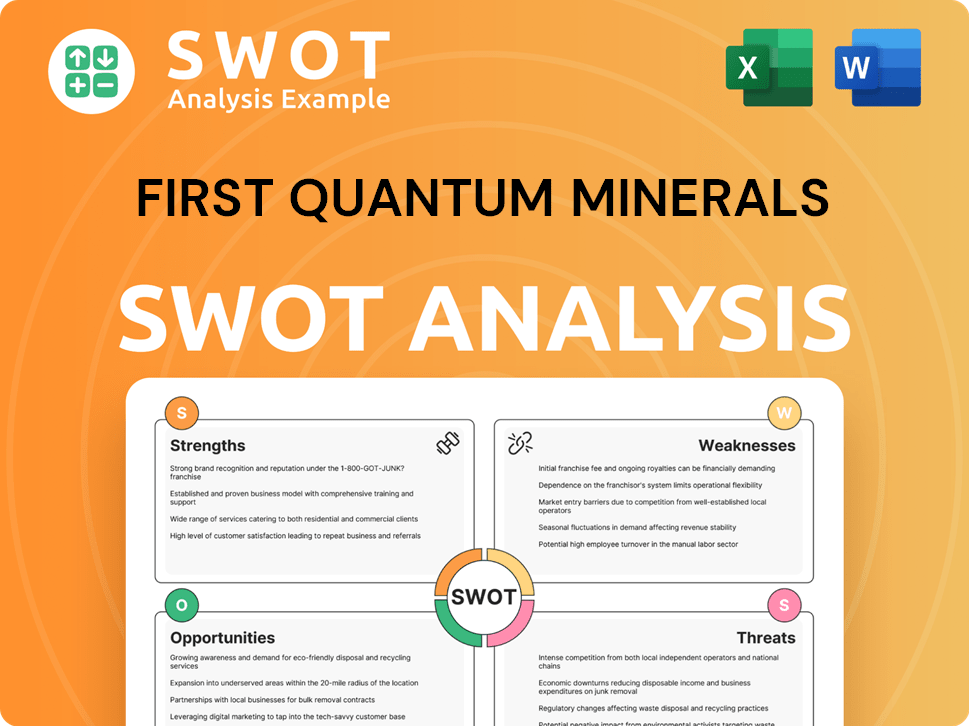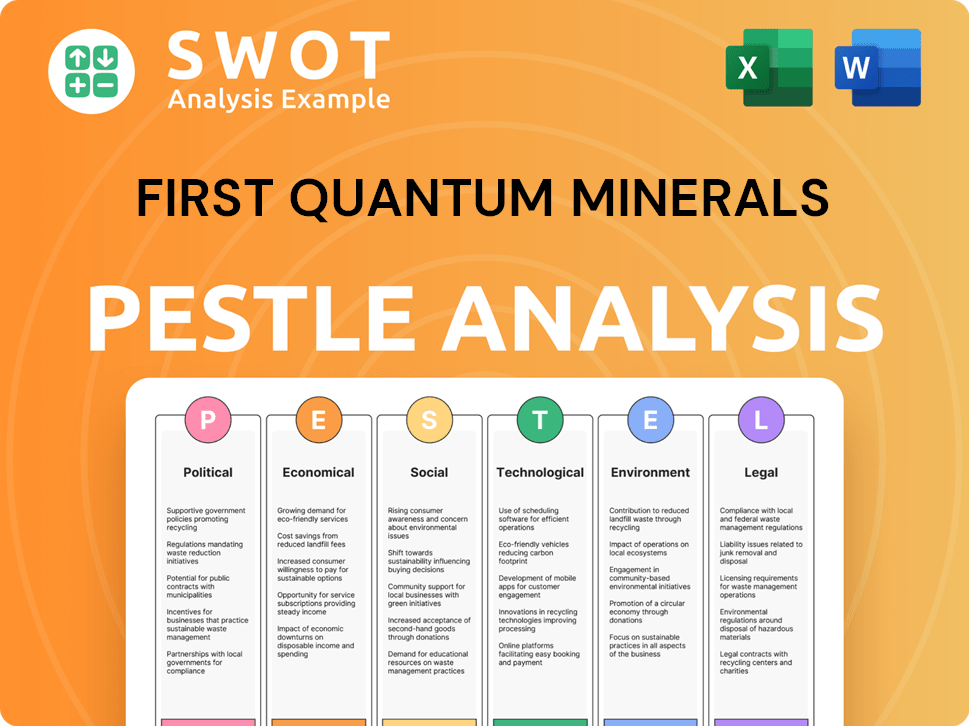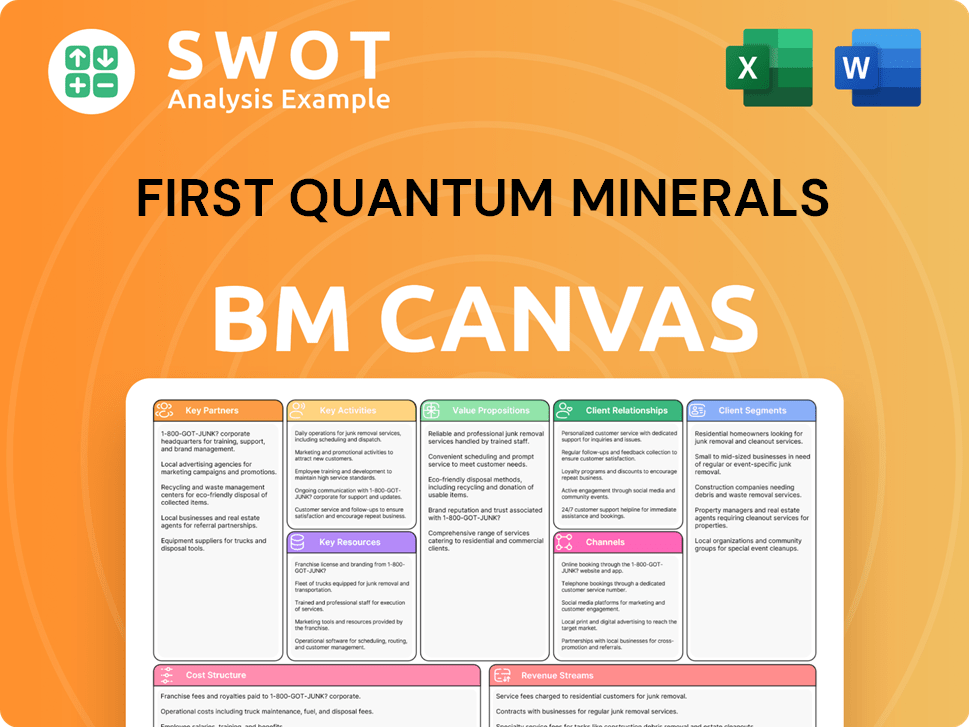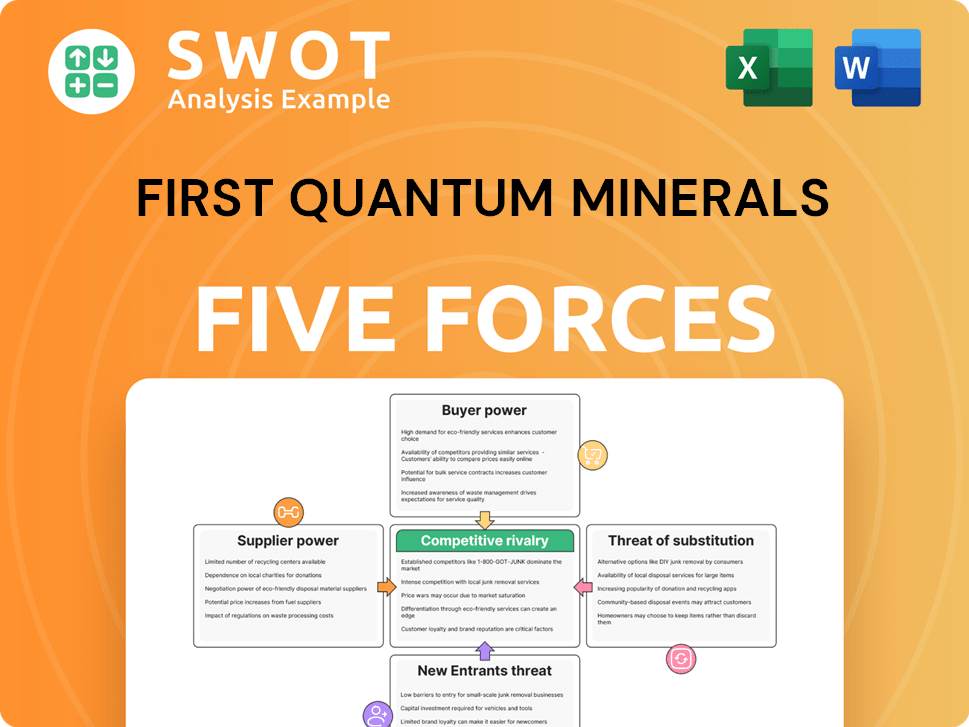First Quantum Minerals Bundle
How Does First Quantum Minerals Stack Up in the Copper Mining Arena?
The global copper market is a battlefield of strategic moves, especially crucial for the energy transition. First Quantum Minerals (FQM) has emerged as a key player. Founded in 1996, the company's growth story is a testament to its strategic acquisitions and operational prowess in the First Quantum Minerals SWOT Analysis.

This deep dive into the competitive landscape will dissect First Quantum Minerals' market position and analyze its key rivals. We'll explore its unique competitive advantages, providing insights into its financial performance and strategic partnerships. Understanding the First Quantum Minerals Competitive Landscape is crucial for any investor or industry professional seeking to navigate the complexities of Copper Mining and assess FQM’s Market Share.
Where Does First Quantum Minerals’ Stand in the Current Market?
First Quantum Minerals (FQM) is a major player in the global copper industry, recognized as one of the world's largest copper producers. The company's core operations involve the exploration, development, and mining of copper deposits, along with the processing and sale of copper and other related products. FQM's value proposition centers on its ability to efficiently extract and process copper, delivering high-quality products to a diverse customer base across various industrial sectors.
In 2023, FQM's copper production reached approximately 707,756 tonnes, highlighting its significant contribution to the global copper supply. The company's primary products include copper concentrate, copper anode, and copper cathode. FQM operates strategically in multiple countries, with significant operations in Africa, Australia, and Latin America, catering to a global customer base.
Over time, FQM has strategically focused on large-scale, low-cost copper production, emphasizing operational efficiency and resource optimization to maintain a competitive edge. This approach has allowed it to navigate market fluctuations effectively. For more information about the company's ownership structure, you can read about the Owners & Shareholders of First Quantum Minerals.
FQM consistently ranks among the top global copper miners, often competing with industry giants. While specific market share figures can vary, FQM's substantial production volume places it in a strong position. The company's financial health, supported by significant revenue and assets, positions it favorably within the industry.
FQM holds a strong position in regions like Zambia and Panama, where it operates large-scale, high-grade copper mines. Its global operations are a key aspect of its competitive strategy. The company's geographic diversification helps mitigate risks and supports its overall market position.
FQM's financial performance is crucial to its market position. The company's revenue and asset base are substantial, supporting its competitive standing. However, the mining sector's capital expenditure demands are ongoing, affecting its financial strategies.
FQM's product portfolio includes copper concentrate, copper anode, and copper cathode, catering to diverse industrial needs. This diversified product offering enhances its market reach. The company's ability to deliver various copper products supports its competitive advantage.
FQM's strengths include its large-scale, low-cost copper production, strategic geographic diversification, and a strong focus on operational efficiency. These factors contribute to its robust market position and ability to compete effectively.
- Large-scale copper production capacity.
- Operational efficiency and cost management.
- Strategic geographic diversification.
- High-quality product offerings.
First Quantum Minerals SWOT Analysis
- Complete SWOT Breakdown
- Fully Customizable
- Editable in Excel & Word
- Professional Formatting
- Investor-Ready Format

Who Are the Main Competitors Challenging First Quantum Minerals?
The competitive landscape for First Quantum Minerals (FQM) is shaped by its position in the global mining industry, particularly within the copper sector. FQM faces competition from both direct and indirect sources, influencing its market share and strategic decisions. Understanding the key players and their strategies is crucial for evaluating FQM's performance and future prospects. A detailed Brief History of First Quantum Minerals can provide further context on its evolution within this competitive environment.
FQM's competitive standing is determined by its ability to manage production costs, secure access to high-grade reserves, and implement technological innovations. The mining industry's dynamics are constantly evolving, with factors such as environmental regulations, geopolitical risks, and commodity price fluctuations significantly impacting competition. Analyzing these elements offers insights into the challenges and opportunities FQM faces.
First Quantum Minerals operates in a highly competitive global mining industry, facing challenges from both direct and indirect competitors. Its most significant direct rivals include other major diversified mining companies with substantial copper operations. These include companies such as BHP, Rio Tinto, Glencore, and Antofagasta PLC.
BHP, a global mining giant, competes through its vast portfolio of copper assets and significant financial resources, often leveraging economies of scale. In 2024, BHP's copper production reached approximately 1.7 million tonnes, demonstrating its substantial market presence. The company's strong financial position allows for aggressive investment in new projects and acquisitions, enhancing its competitive edge.
Rio Tinto, another diversified miner, challenges FQM with its large-scale copper projects and technological advancements in mining. Rio Tinto's copper production in 2024 was around 580,000 tonnes. The company focuses on operational efficiency and technological innovation to maintain its competitiveness.
Glencore, with its integrated mining and trading operations, poses a competitive threat through its market reach and supply chain efficiencies. Glencore's copper production in 2024 was approximately 1.1 million tonnes. Its trading arm provides significant market access and flexibility in managing commodity prices.
Antofagasta PLC, focused primarily on copper, competes through its established operations in Chile and consistent production. Antofagasta produced around 660,000 tonnes of copper in 2024. The company's focus on copper allows for specialized expertise and efficient operations.
These competitors challenge First Quantum Minerals through various avenues, including production volume, cost efficiency, technological innovation, and access to new reserves. For instance, high-profile 'battles' often emerge around the acquisition of new exploration licenses or the development of new mines, where companies vie for access to high-grade deposits. Recent mergers and alliances, such as BHP's proposed acquisition of Anglo American, could significantly reshape the competitive dynamics by consolidating market power and potentially increasing the scale of some rivals. Emerging players, particularly those focused on sustainable mining practices or innovative extraction technologies, also represent a potential disruption to the traditional competitive landscape.
The competitive landscape is also influenced by market dynamics such as copper prices and demand from end-use industries. In 2024, copper prices fluctuated, affecting the profitability of all producers. Additionally, the increasing focus on environmental, social, and governance (ESG) factors is driving changes in mining practices and investment strategies, further influencing the competitive dynamics.
FQM's competitive position is determined by its ability to manage costs, efficiently operate its mines, and secure new resources. Key factors include:
- Production Costs: Minimizing the cost of production is crucial for profitability, especially during periods of low copper prices.
- Operational Efficiency: Efficient mine operations and processing are essential for maximizing output and minimizing waste.
- Access to Reserves: Securing access to high-grade copper deposits is critical for long-term sustainability.
- Technological Innovation: Adopting new technologies can improve efficiency, reduce costs, and enhance environmental performance.
- Geopolitical Risks: Navigating political and regulatory environments in various countries is essential for successful operations.
First Quantum Minerals PESTLE Analysis
- Covers All 6 PESTLE Categories
- No Research Needed – Save Hours of Work
- Built by Experts, Trusted by Consultants
- Instant Download, Ready to Use
- 100% Editable, Fully Customizable

What Gives First Quantum Minerals a Competitive Edge Over Its Rivals?
First Quantum Minerals (FQM) carves out a strong position in the global copper market, underpinned by a strategic focus on large-scale, long-life, and low-cost copper mines. This approach allows the company to maintain profitability and navigate fluctuations in copper prices effectively. The company's operational expertise, particularly in developing and managing complex mining projects in challenging areas, is a key differentiator in the Competitive Landscape.
A significant advantage for FQM lies in its integrated operational model, encompassing exploration, development, mining, and processing. This vertical integration provides greater control over the supply chain and enhances efficiency across various production stages. Furthermore, the company consistently invests in technological advancements to optimize its operational performance, although specific proprietary technologies are not always publicly detailed. These strategic moves contribute to FQM's Competitive Edge.
The company's established relationships with local communities and governments, while sometimes presenting challenges, can provide a more stable operating environment. FQM continually strives to optimize its existing assets and acquire new high-potential projects to sustain and grow its production base. However, the company faces potential threats from rising operational costs and increasing regulatory scrutiny within the mining sector.
FQM's portfolio includes significant assets like Cobre Panama and Kansanshi, which are crucial for substantial production volumes and cost efficiencies. These mines enable the company to remain competitive, even during periods of lower copper prices. The focus on these types of mines is a core element of FQM's strategy.
FQM demonstrates strong capabilities in developing and operating complex mining projects, often in difficult jurisdictions. This proficiency allows for the efficient commissioning of large-scale projects and effective management throughout their lifecycle. This operational skill set is a key competitive advantage.
The company's integrated approach, spanning from exploration to processing, offers greater control over the supply chain. This integration allows for optimization at various stages of production, enhancing overall efficiency. Vertical integration is a strategic advantage in the Copper Mining industry.
FQM invests in technology and innovation to improve its operational performance. While specific proprietary technologies aren't always detailed, the company's commitment to technological advancement supports its competitive position. This focus on innovation helps maintain its industry position.
FQM's key advantages include a portfolio of large-scale, long-life, and low-cost copper mines, operational expertise in complex projects, and an integrated operational model. These strengths allow for efficient production and control over the supply chain. The company's focus on these areas enhances its Market Share.
- Large-scale, long-life, and low-cost copper mines
- Operational expertise in complex projects
- Integrated operational model (exploration, development, mining, and processing)
- Investments in technology and innovation
First Quantum Minerals Business Model Canvas
- Complete 9-Block Business Model Canvas
- Effortlessly Communicate Your Business Strategy
- Investor-Ready BMC Format
- 100% Editable and Customizable
- Clear and Structured Layout

What Industry Trends Are Reshaping First Quantum Minerals’s Competitive Landscape?
The global copper industry is currently undergoing significant shifts, creating both opportunities and challenges for major players like First Quantum Minerals (FQM). The increasing demand for copper, driven by the energy transition and the rise of electric vehicles, is a key trend influencing the Competitive Landscape. However, FQM must navigate evolving regulatory environments, manage geopolitical risks, and optimize operational efficiencies to maintain its market position.
Analyzing the Mining Company Analysis reveals that FQM's future hinges on its ability to adapt to these changes. The company's industry position is affected by its ability to develop new projects, form strategic partnerships, and embrace technological advancements while mitigating risks associated with resource nationalism and fluctuating input costs. Understanding these dynamics is crucial for assessing FQM's long-term prospects.
The energy transition is boosting copper demand, with electric vehicles and renewable energy infrastructure requiring significant amounts of the metal. Technological advancements, such as automation and AI, are transforming mining operations. Environmental, Social, and Governance (ESG) factors are becoming increasingly important in the industry.
Stringent environmental regulations and ESG requirements necessitate substantial investment in sustainable practices. Geopolitical risks and resource nationalism in operating regions can disrupt operations. Rising input costs, including energy and labor, can impact profitability. The emergence of disruptive extraction technologies could also pose challenges.
Expanding production through new project development and the optimization of existing mines is a key opportunity. Strategic partnerships and joint ventures can provide avenues for growth and risk mitigation. Adapting to changing regulatory landscapes and embracing technological innovation are also crucial.
Focusing on sustainable practices, operational excellence, and strategic growth initiatives is essential. Successfully navigating geopolitical complexities and capitalizing on the growing demand for copper are critical for long-term success. FQM's ability to manage these elements determines its market share.
To ensure sustained growth, FQM must address several key areas. This includes adapting to the evolving Competitive Landscape and leveraging opportunities while mitigating risks. The ability to adapt and innovate will be crucial for FQM's future success.
- Production Capacity: FQM's ability to increase copper production through new projects and expansions is critical. For example, the company's Kansanshi mine in Zambia is a significant contributor to its overall output.
- Operational Efficiency: Implementing advanced technologies to improve efficiency, reduce costs, and minimize environmental impact is essential.
- Strategic Partnerships: Forming joint ventures and strategic alliances can help FQM manage risks and access new markets.
- ESG Compliance: Meeting stringent environmental and social governance standards is vital for maintaining a positive reputation and securing operational licenses.
For further insights into FQM's business model and revenue streams, explore the analysis of Revenue Streams & Business Model of First Quantum Minerals. This article provides additional details on the company's operations and financial performance.
First Quantum Minerals Porter's Five Forces Analysis
- Covers All 5 Competitive Forces in Detail
- Structured for Consultants, Students, and Founders
- 100% Editable in Microsoft Word & Excel
- Instant Digital Download – Use Immediately
- Compatible with Mac & PC – Fully Unlocked

Related Blogs
- What are Mission Vision & Core Values of First Quantum Minerals Company?
- What is Growth Strategy and Future Prospects of First Quantum Minerals Company?
- How Does First Quantum Minerals Company Work?
- What is Sales and Marketing Strategy of First Quantum Minerals Company?
- What is Brief History of First Quantum Minerals Company?
- Who Owns First Quantum Minerals Company?
- What is Customer Demographics and Target Market of First Quantum Minerals Company?
Disclaimer
All information, articles, and product details provided on this website are for general informational and educational purposes only. We do not claim any ownership over, nor do we intend to infringe upon, any trademarks, copyrights, logos, brand names, or other intellectual property mentioned or depicted on this site. Such intellectual property remains the property of its respective owners, and any references here are made solely for identification or informational purposes, without implying any affiliation, endorsement, or partnership.
We make no representations or warranties, express or implied, regarding the accuracy, completeness, or suitability of any content or products presented. Nothing on this website should be construed as legal, tax, investment, financial, medical, or other professional advice. In addition, no part of this site—including articles or product references—constitutes a solicitation, recommendation, endorsement, advertisement, or offer to buy or sell any securities, franchises, or other financial instruments, particularly in jurisdictions where such activity would be unlawful.
All content is of a general nature and may not address the specific circumstances of any individual or entity. It is not a substitute for professional advice or services. Any actions you take based on the information provided here are strictly at your own risk. You accept full responsibility for any decisions or outcomes arising from your use of this website and agree to release us from any liability in connection with your use of, or reliance upon, the content or products found herein.